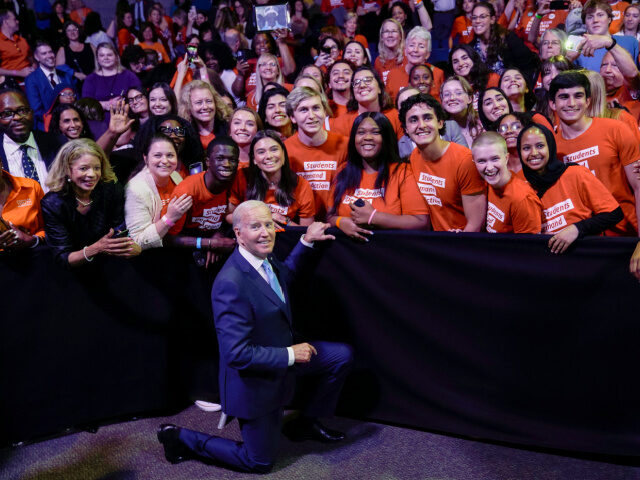President Joe Biden will announce Monday that student debt held by ten million Americans will transfer to taxpayers, White House officials told reporters Monday.
The plan to convey student loan debt to taxpayers is widely seen as a political move to gain electoral traction among young voters, who largely do not approve of Biden’s leadership.
Taxpayers can expect to absorb about $5,000 for each of the ten million students, according to the plan Biden is set to tout in Wisconsin. Overall, Biden intends to cut the amount that 23 million students owe on their loans, placing the burden on taxpayers to shoulder the burden of the entire loan amount for more than four million Americans.
FLASHBACK — Sen. Roy Blunt: Biden’s Student Loan Forgiveness ‘Monumentally Unfair’
“Today’s announcement shows that we are continuing to fulfill our promises,” Miguel Cardona, the secretary of education, told reporters Sunday. “We’re delivering as much relief as possible, for as many borrowers as possible, as quickly as possible.”
The plan’s purpose is to drive support for Biden ahead of the November election, the New York Times admitted:
If Mr. Biden succeeds in putting the new plan into effect before the November election, it may help rally support among voters who were intensely disappointed that the president failed in his first plan, which would have eliminated up to $20,000 in debt for tens of millions of borrowers.
But the president faces steep obstacles in the legal system and the calendar. The new plan will require a monthslong public comment period before it can take effect. Officials said on Sunday that only some of the provisions would begin going into effect in “early fall” of this year.
Officials also expect legal challenges from Republicans, which could take months to resolve. That could leave the plan in limbo as voters go to the polls in November to choose between Mr. Biden and former President Donald J. Trump.
Biden’s previous attempt to transfer student loans to taxpayers failed at the Supreme Court. Since then, Biden used his executive power to transfer $138 billion in student loan debt from four million borrowers to taxpayers.
According to the White House, the plans Biden will announce, if finalized as proposed, would deliver some amount of relief to:
- Borrowers who owe more than they did at the start of repayment. Millions of borrowers across the country owe more than they did when they started repaying because of accrued and capitalized interest. Black and Latino borrowers are likelier to experience growth in their student loan balances due to excessive interest accumulation. Four years after graduation, Black bachelor’s degree borrowers on average owe more than they borrowed.
- Borrowers who are otherwise eligible for loan forgiveness, but have not yet applied. Borrowers face administrative burdens with completing loan forgiveness applications. Many borrowers would receive automatic debt relief for loan forgiveness programs that they are eligible for but have not successfully applied for, such as the Saving on a Valuable Education (SAVE) Plan, Public Service Loan Forgiveness, or other forgiveness programs.
- Borrowers who first entered repayment many years ago. Many borrowers are repaying their loans decades after leaving school. The Administration’s new plan would cancel debt for all borrowers with only undergraduate student debt who entered repayment 20 or more years ago and cancel loans for borrowers with any graduate student debt that first entered repayment 25 or more years ago.
- Borrowers who enrolled in low-financial-value programs. Those who attended institutions or programs that failed accountability measures or failed to provide students with sufficient financial value would be eligible for relief, including those whose institutions closed prior to the finalization of such determinations. Black and Latino borrowers make up a disproportionately larger share of students enrolled in these programs.
- Borrowers experiencing hardship paying back their loans. Millions of borrowers could be eligible for relief if they are experiencing hardship in their daily lives that prevent them from fully paying back their loans now or in the future. Black and Latino borrowers have higher default rates than white borrowers, undermining their ability to build generational wealth, start businesses, buy homes, and more.
Wendell Husebo is a political reporter with Breitbart News and a former GOP War Room Analyst. He is the author of Politics of Slave Morality. Follow Wendell on “X” @WendellHusebø or on Truth Social @WendellHusebo.

COMMENTS
Please let us know if you're having issues with commenting.